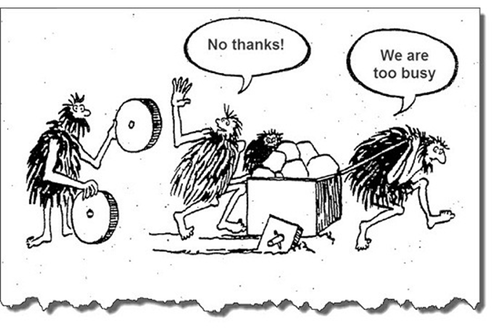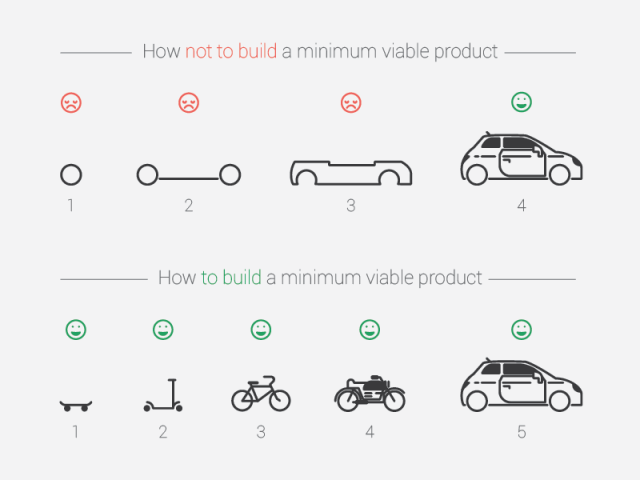
The cartoon above depicts a common problem in hi-tech companies: Someone invents a new technology, but is not able to promote its adoption. I think the solution is that instead of just providing the “wheels”, we need to build a prototype of the entire vehicle and then show how it can transport real stones…
The main problem with just inventing the wheels is that it may be very difficult to demonstrate its business value. Very often a new technology is only useful as part of a more complex system, and until this technology has not been integrated in such a system its potential contribution is only hypothetical.
In contrast, the picture below displays the wrong and right ways to build a Minimum Viable Product (MVP). In both cases we have a form of incremental development. But in the wrong way the initial stages are such that the business value cannot be assessed. In the right way the business value is evident from the beginning, even if the initial versions are quite different from the final product.

Therefore, Invention is not enough for Innovation. For an invention to be adopted we must be able to prove its value. For an additional discussion on this topic, please see also my article about the Minimum Viable Product and Incremental Software Development.
What do you think? What has been your experience with Invention and Innovation? Please share with us in the comments below.

Part of the problem re: value is that people tend to think in terms of value = benefit – cost where it’s really Value = (Benefit + Perception) – (Cost + Perception) and the perception will likely outweigh the tangible.
Agree! And this is the reason we need validated learning through the Lean feedback loop.
Taking lot of liberties with the context, have this comment.
The guy offering the wheels (the invention or a fix for the problem at hand) in your cartoon may need to turn off his invention side and bring on his artful side to influence the other two dudes who are hard at work!
Why must they trust his wheels! There is a risk that the wheels are faulty and buckle under the weight of the cart!
The idea of gaining mind share by selling an idea is probably an art in itself! Steve Jobs was at the forefront of this and was able to articulate his ideas to the world! However, was he an engineer? No?
This is indeed a rather difficult thing for engineers! Perhaps that is why many stop at the border of invention and never proceed to the town called Innovation! It is also the next stage of evolution that turns an engineer into an entrepreneur!
Thanks for your comment, Ravi! I agree that most engineers could greatly benefit of thinking like entrepreneurs!
This is one reason why the lower sequence for MVP makes sense. Since the development is “the whole”, at each stage the wheel buckling risk is minimised. This is quintessentially an Engineer-speak.
But I hear the perception perspective well. The Line of Business or the Marketing people could require significant persuasion to be convinced of the time on the wheels, from 2.3 to 2.4. Engineers should raise their heads more often 🙂
Pingback: Thing16: one note | Wildcatblogs
Pingback: Erfolgsprinzip Minimum Viable Products | Michael Frei
Pingback: Co je projektový trojimperativ a jak ho použít v praxi - Freelo